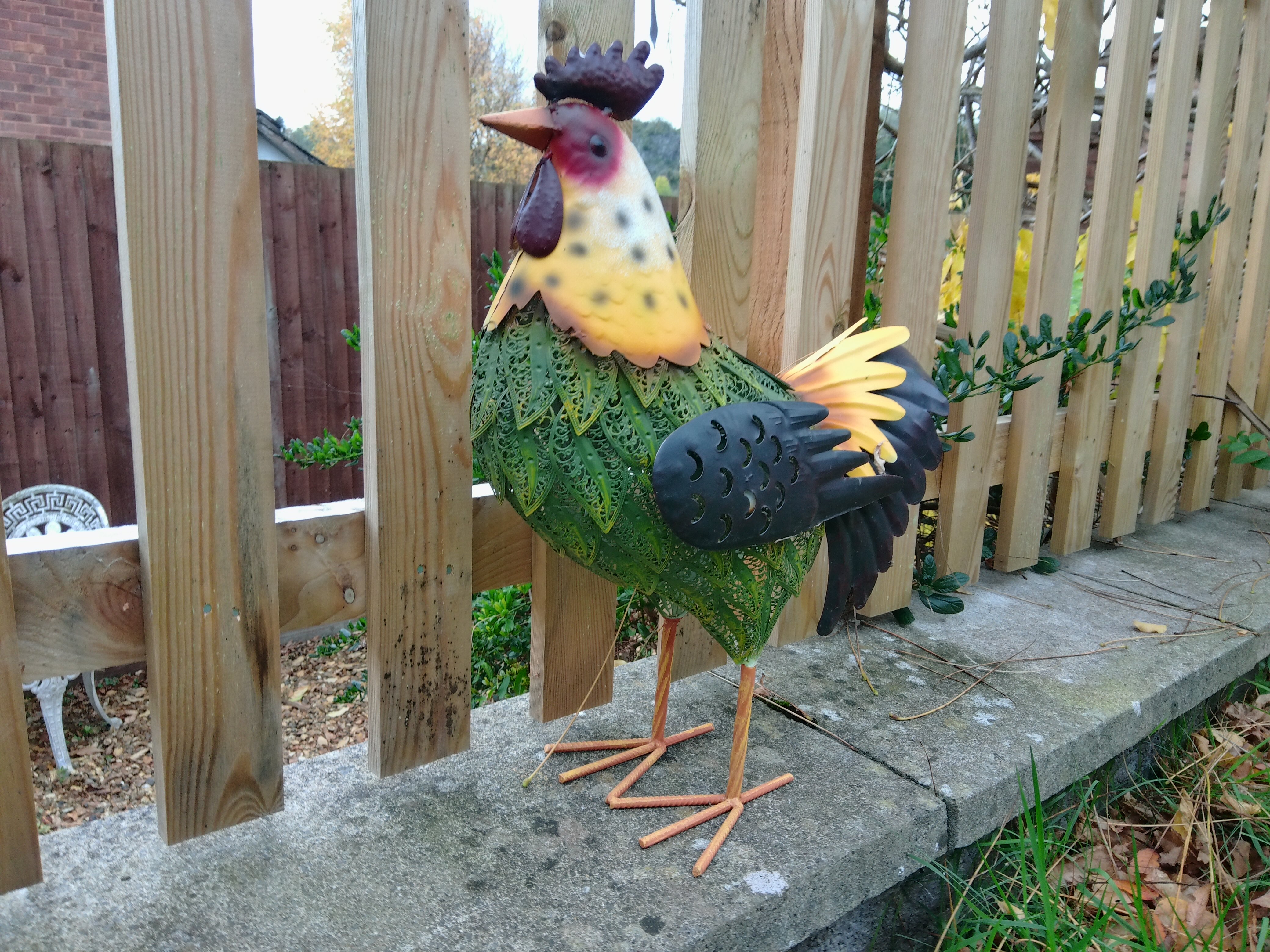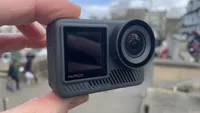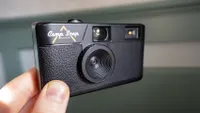TechRadar Verdict
If you see it in pictures, the PixPro C1 looks amazing, but when you pick it up you realize it is just an inexpensive plastic camera, and when you start taking pictures, that’s when reality hits home. Sorry to say, the pretty-looking C1 takes pictures that would have been disappointing on a cheap point and shoot camera ten years ago, and its sluggish operation just makes things worse. Nice try, Kodak, but honestly you’ll get much better shots from your phone.
Pros
- +
Very pretty
- +
Very cheap
- +
180-degree flip-up screen
- +
Simple and effective menus
Cons
- -
Digital zoom only
- -
Poor picture quality
- -
Basic 1-point autofocus
- -
Very sluggish
Why you can trust TechRadar
Kodak PixPro C1: Two-minute review
Compact cameras are suddenly trending, including simple pocket-sized point and shoot cameras, and Kodak is riding the wave with the PixPro C1. It’s pretty, it’s cheap and it looks like the perfect antidote to complex mirrorless cameras or expensive smartphones. But can a camera this cheap be any good?
Sadly, it doesn’t take long to answer that question. The PixPro C1 is pretty plasticky, as you would expect at this price, but it looks the part and it has a flip-up selfie screen and a basic but effective set of controls that makes it easy to use. It’s what’s inside that’s the problem.
The C1 uses a very small 13MP 1/1.3-inch sensor of unknown vintage that exhibits all the characteristics of old point and shoot cameras that we’ve conveniently forgotten, with image quality that’s OK in good light but rapidly disintegrates if you need to use a higher ISO in low light or if you use the digital zoom.

Yes, it’s a digital zoom not an optical one. The tiny sensor’s image quality is already stretched to the limit in perfect conditions, so the digital zoom just magnifies its limitations. At the maximum 4x zoom setting you get photos that might look OK on a phone screen, but not so much on a tablet and definitely not in a print. You really are better off sticking to the native focal length, and at 26mm equivalent, this is pretty wide, much like the main camera on a phone.
This camera’s other major issue is its slow response. The single (center) point autofocus can take half a second or a second to lock on, and when you press the shutter release there’s a further delay of a second while the screen goes black… and then you get the shutter sound. It’s very difficult to time your exposures with moving subjects, and the Kodak’s slim, slippery shape makes it difficult to keep it steady – there’s no image stabilization.
So from the outside the Kodak PixPro C1 is quite smart, but inside it uses tech that could have come straight from an old phone or a very cheap point and shoot compact from ten years ago. It’s very disappointing.
Kodak PixPro C1: price
- Priced at $99 / £79 / AU$154
- USB cable and wrist strap included
- Available now
The Kodak PixPro C1 sells for around $99 / £79 (about AU$154). That doesn’t sound much for a fully-functioning pocket-sized digital camera, but it’s quite a lot to spend on something that you end up not using because your smartphone is so much better. That price doesn’t include a memory card, though our sample included a microSD card and card reader, so bundles may vary.
Sign up for breaking news, reviews, opinion, top tech deals, and more.
Kodak PixPro C1: specs
Type: | Pocket sized compact camera |
Sensor: | 13MP 1/1.3-in CMOS |
Lens: | 3.57mm (26mm equivalent) f/2, up to 4x digital zoom |
Focus range: | 0.6m-infinity, 0.08m macro |
ISO: | 100-1600 |
Video | 1920x1080 up to 60fps |
Storage: | microSD, up to 32GB |
EVF: | No |
Stabilization: | No |
Flash/light: | Built in |
Screen: | 180-degree tilting, 2.8-in, 230k-dot |
Battery: | Built in, non-removable, 200 shots approx. |
Size: | 103 x 60 x 20.3mm, 115g |
Kodak PixPro C1: design
- Slim, light, smart styling
- Plasticky feel but solid enough at the price
- Memory card slot exposed in the base – no door
- Phone-style LED ‘flash’
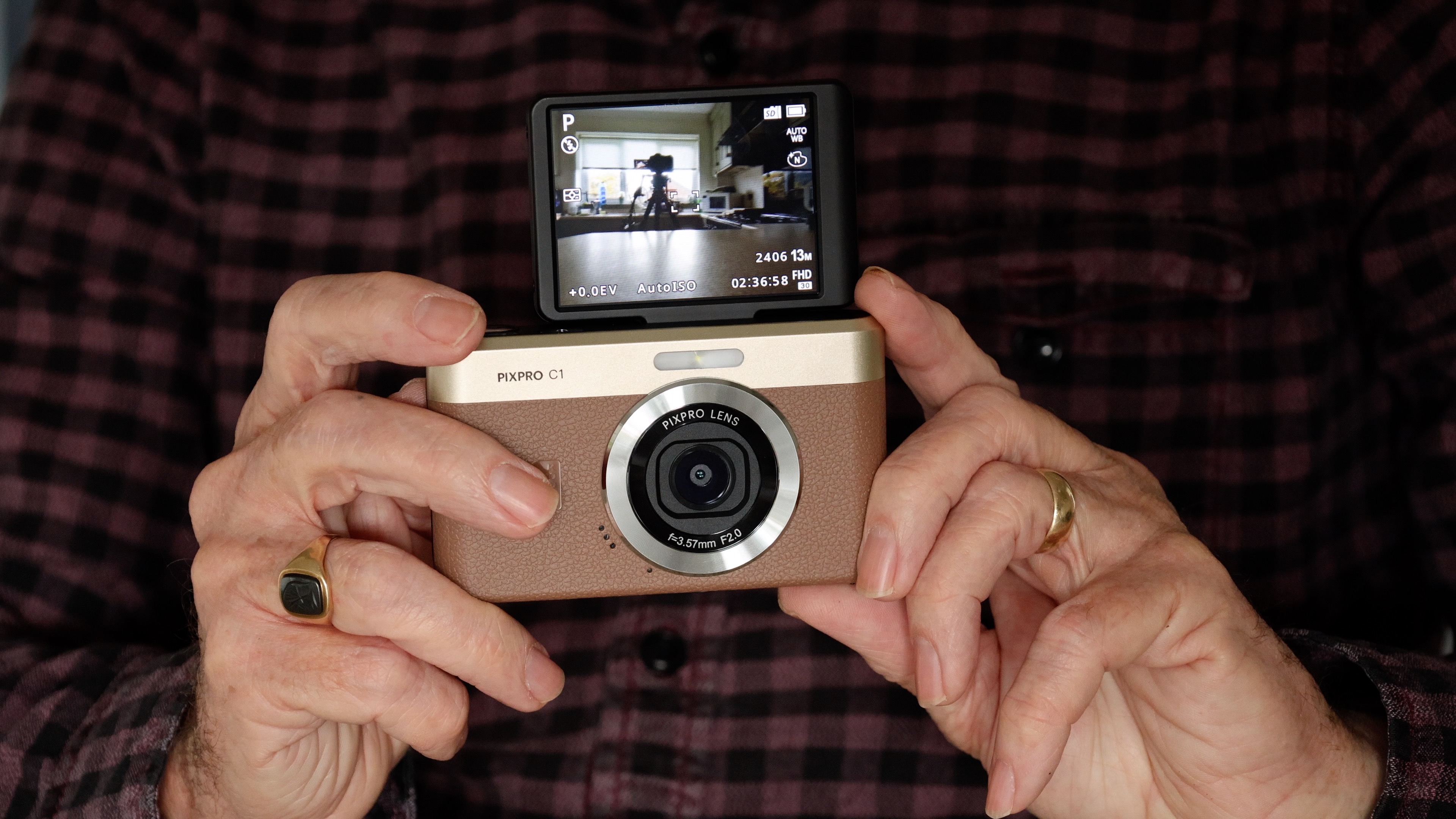
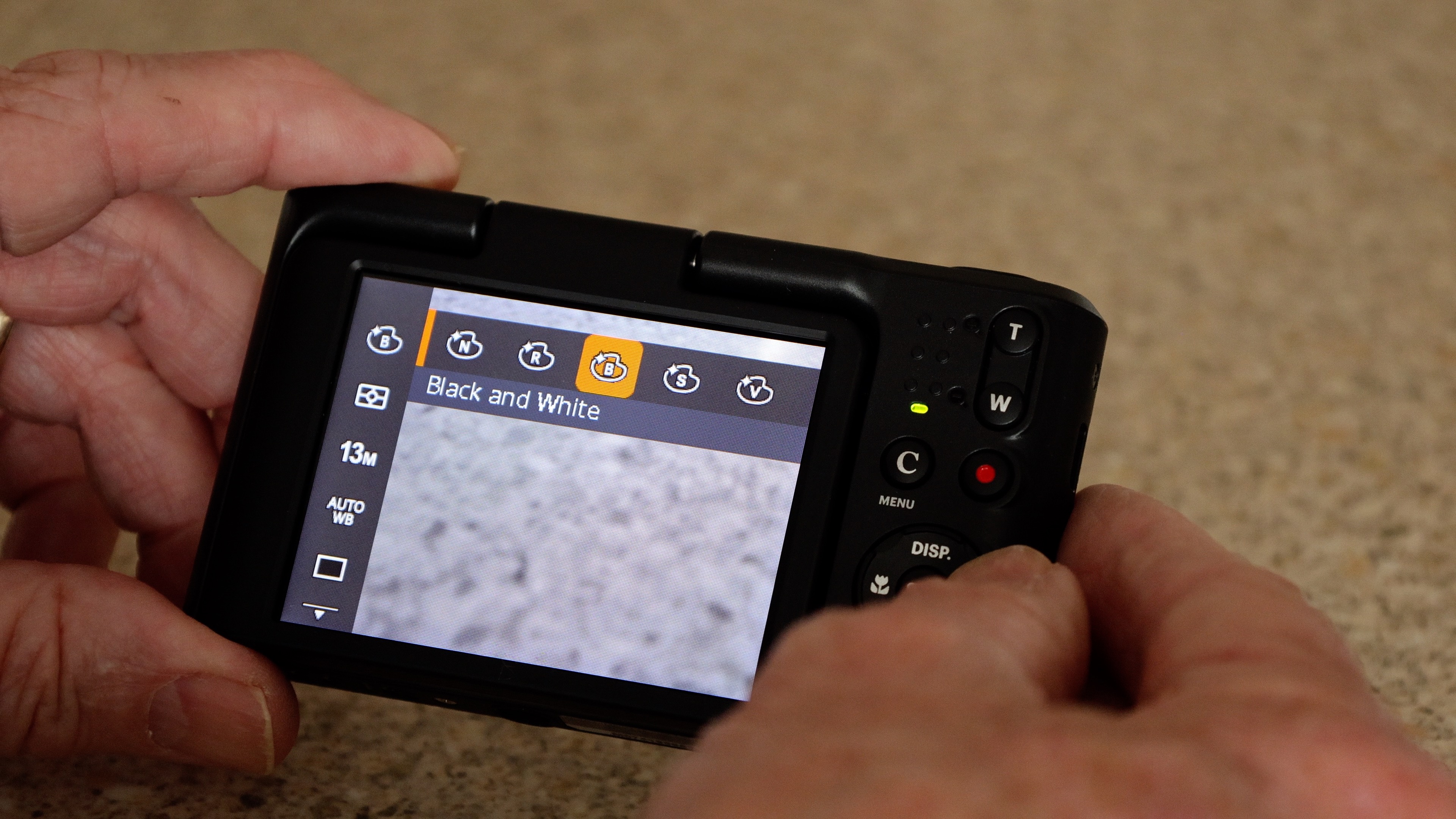

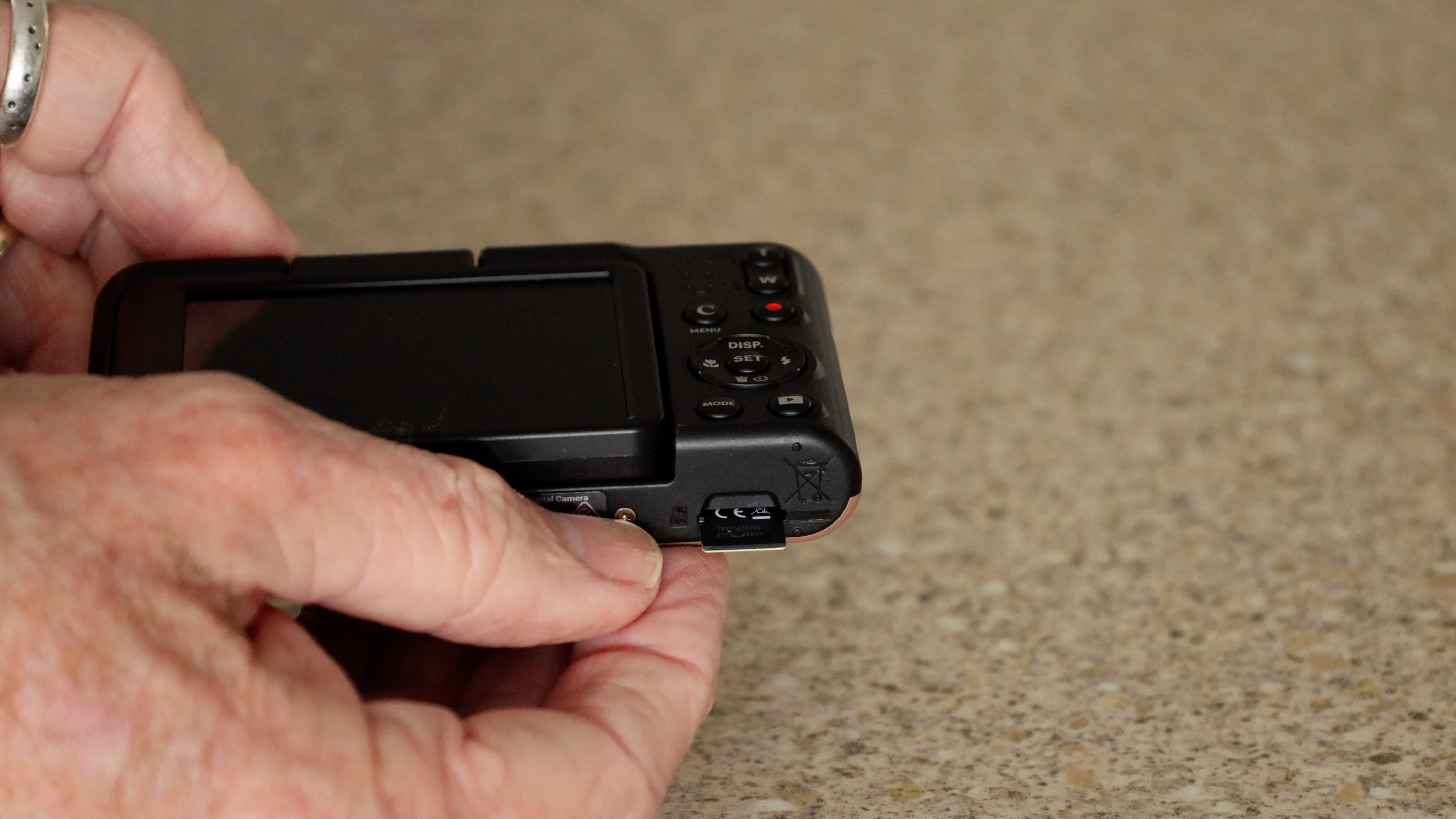
We forget how small point and shoot cameras used to be! The Kodak PixPro C1 will easily slip into a shirt pocket or a trouser pocket, and because it weighs just 115g, you’ll hardly know it’s there. It’s available in a black or tan or brown finish – mine came in brown, and it does look pretty classy.
It does feel plasticky when you pick it up, however, especially round the back where the screen and the controls are. The top edge of the screen has a hinge so that you can flip it up to face forward for selfies, and to the right you’ve got a four-way controller, menu, playback, mode and record buttons, plus a rocker for the zoom.
You can shoot in full auto mode, switch to program mode for a little more control, or use a small selection of ‘scene’ modes. The menu button displays options for picture styles, metering pattern, resolution (just in case you want less than 13 megapixels!), white balance and continuous versus single shot mode. The menus are basic but clear.
There is a built in flash – well, sort of, as it’s actually a phone-style LED, but that’s fine. Underneath, in the base of the camera, you’ll find the memory card slot, which takes microSD cards. There’s no door or cover of any sort – the card just pushes into the slot, where it’s flush with the base so you can still stand the camera on a flat surface.
It’s all very basic but effective, and exactly what you would expect from a cheap camera. It’s not too daunting for beginners, either.
Kodak PixPro C1: performance
- Sluggish shutter action
- Poor image quality at higher ISOs
- Digital zoom not worth using
- Autofocus struggles/fails in low light
Physically, the PixPro C1 is pretty decent at this price. It’s the performance that’s disappointing. You could argue that you shouldn’t expect much for this money, but there comes a point where a product just isn’t good enough to use, regardless of how cheap it is, and the PixPro C1 sails pretty close to the wind here.
Before you even get to look at its images, its operation feels very vague and sluggish. The AF is not particularly quick, but the worst part is the shutter action, which takes about a second to complete and only makes a shutter sound at the end. This is not a camera for fast action or grabbed shots. Not only that, the rear screen gets quite hard to see in bright light.
As for the pictures… well, it depends on what you are expecting. The resolution, dynamic range and noise are just what you would expect from a small sensor of the old days, and not a patch on what a modern smartphone camera array would produce. In good outdoor light where you don’t need a higher ISO and there’s little risk of camera shake, the images are OK. But in poor light at higher ISOs the detail smudges and object edges become hyper-processed and things aren’t good at all.

If you do use the zoom, you quickly realize that the 13MP sensor really can’t stand a lot of cropping. Or any cropping, to be honest.
I did try the ‘flash’ indoors. There’s nothing wrong with the illumination it provides, but it only comes on when the camera has focused, and in my tests the autofocus struggled if it was too dark, and without sharp focus the flash wasn’t much help.

Should you buy the Kodak PixPro C1?
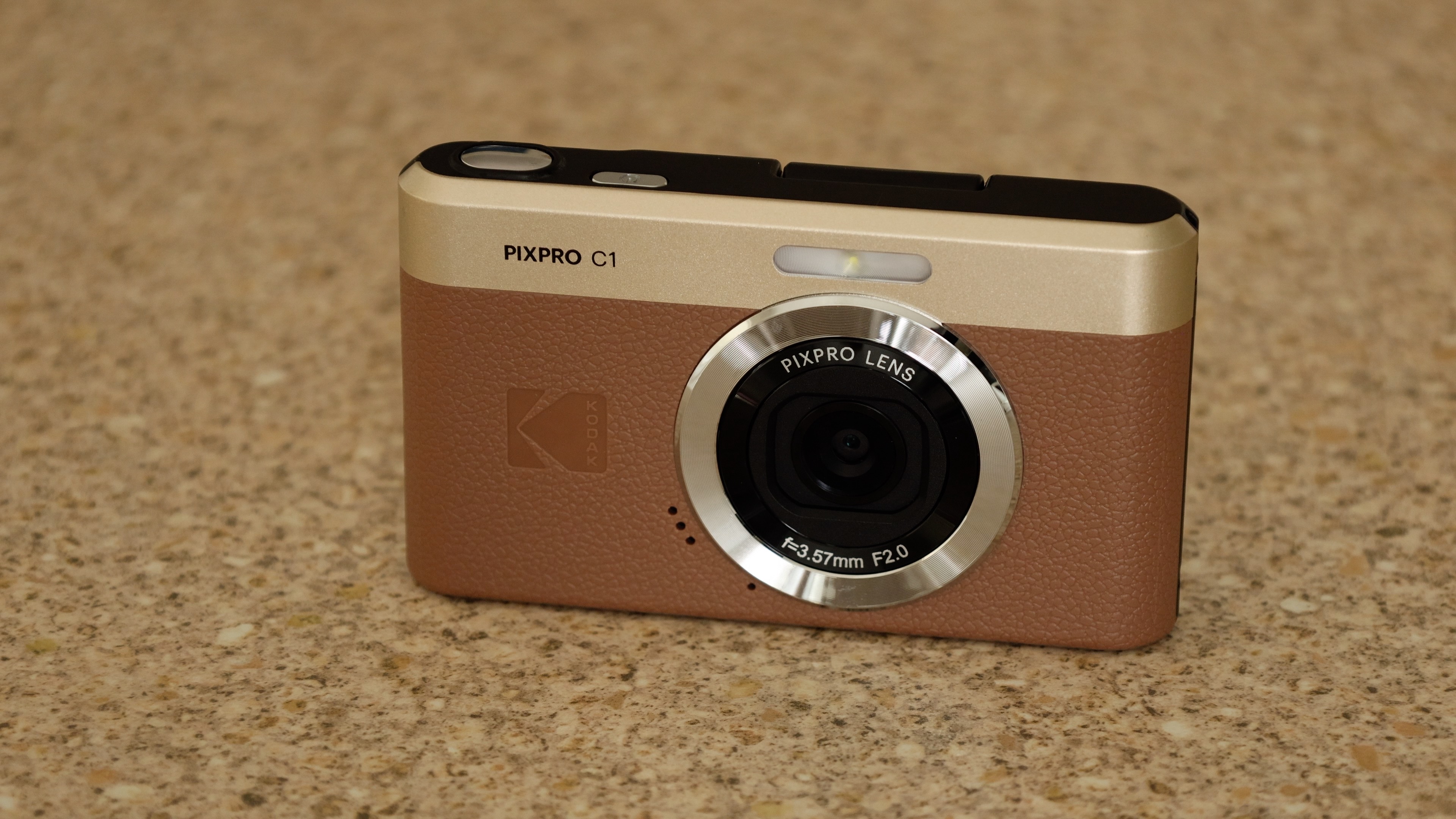
Buy it if...
You just need a cheap camera
The PixPro C1 makes a certain amount of sense as a basic camera you don’t need to worry about for school trips, as a gift, or as a ‘just in case’ camera to keep in your vehicle’s glovebox or your coat pocket
You want a lightweight pocket camera
The Kodak is lighter than a smartphone, probably won’t fall out of your pocket as easily and has a simple clarity of purpose that a lot of people like in their gadgets
You want to relive those retro point-and-shoot years
This is a big thing at the moment, as modern photographers yearn for the simplicity of the old days and the flawed but characterful look of old digital cameras. If character is the word
Don't buy it if...
You’re expecting modern digital quality
The PixPro C1 uses very old, very basic sensor technology that would have earned it a bit of a roasting even ten years ago
You want a cheap and effective ‘street snapper’
The Kodak’s responses are way too slow for any kind of ‘snap reaction’ photography. It’s actually quite difficult to time your shots, and you have to hope your subjects will wait
You need the versatility of a zoom
I’ve seen the PixPro C1 advertised (mistakenly) in some places as having a 4x ‘optical’ zoom. It doesn’t. It’s digital, and the sensor really doesn’t have the resolution or quality to make the digital zoom feature useful.
Also consider
Akaso Brave Lite
Yes, the Akaso Brave Lite is an action, camera, but hear me out. It’s small, it’s rugged, it takes 20MP stills and shoots 4K video. An action camera is like a point and shoot but with added versatility. The Brave Lite doesn’t even cost a whole lot more than the PixPro C1.
Read our Akaso Brave Lite review
CampSnap camera
Think the Kodak PixPro C1 is cheap? How about the cheaper-still CampSnap camera? It's essentially a digital reimagining of the single-use disposable film cameras, with a memory card already inside that can hold up to 2,000 pictures.
Read our CampSnap camera review
Fujifilm X Half
The Fujifilm X Half is perfect if you’re serious about re-living those retro shooting vibes and you don’t want to take a big drop in image quality and responsiveness. Yes, it costs a LOT more than the PixPro C1, but it will take far better pictures and probably give you a lot more pleasure.
Read our Fujifilm X Half review
How I tested the Kodak PixPro C1

- I tested it over a period of two weeks
- I tried it with a variety of subjects and lighting conditions
- I also assessed its responsiveness and ease of use
I’ve had the Kodak PixPro C1 for a couple of weeks, which has given me the chance to try it out in all kinds of situations where a camera like this might be used, including outdoor shots, close-ups, indoor scenes and pet pictures. I wanted to give it every chance to show what it could do and how it would react to typical point and shoot situations.
Obviously I wasn’t expecting top image quality, just pictures that were good enough for the purpose. I did feel the Kodak needed to prove it was better than a smartphone or at least as good. Most poeple already have a smartphone with a decent camera, so the Kodak did need to bring something else to the table.
It’s not just the image quality that’s important, but overall handling, usability and responsiveness, and that’s how I approached the PixPro C1.
- First reviewed November 2025

Rod is an independent photographer and photography journalist with more than 30 years' experience. He's previously worked as Head of Testing for Future’s photography magazines, including Digital Camera, N-Photo, PhotoPlus, Professional Photography, Photography Week and Practical Photoshop, and as Reviews Editor on Digital Camera World.
You must confirm your public display name before commenting
Please logout and then login again, you will then be prompted to enter your display name.




